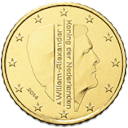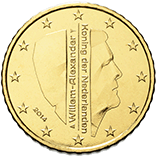Dutch euro coins currently use two designs by Erwin Olaf, both of which feature a portrait of King Willem-Alexander of the Netherlands. The new designs began circulating in 2014. [1] Dutch Euro coins minted from 1999 to 2013 feature a portrait of Queen Beatrix designed by Bruno Ninaber van Eyben. All coins share the 12 stars of the EU and the year of imprint in their design.
Contents
- Dutch euro design
- First series (1999–2013): Queen Beatrix
- Second series (2014–present): King Willem Alexander
- Circulating mintage quantities
- Changes to national sides
- King Willem Alexander
- €2 commemorative coins
- Other commemorative coins (Collectors' coins)
- See also
- References
- External links

As is the case in Finland, most Dutch shops have elected not to issue one and two cent coins starting on 1 September 2004, though the coins remain legal tender. Sums are rounded to the nearest five cents; sums ending in 1, 2, 6 or 7 cents are rounded down, and those ending in 3, 4, 8 or 9 cents are rounded up. The rounding is applied to the grand total only, while individual prices are still shown and summed up with €0.01 precision. This method is known as "Swedish rounding".















